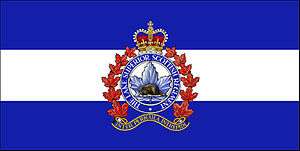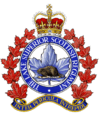The Lake Superior Scottish Regiment
| The Lake Superior Scottish Regiment | |
|---|---|
|
Badge of the Lake Superior Scottish Regiment | |
| Active | 1905 – Present |
| Country | Canada |
| Branch | Militia |
| Type | Line Infantry |
| Role | Light Infantry |
| Size | One Battalion |
| Part of | Royal Canadian Infantry Corps |
| Garrison/HQ |
The Armoury Thunder Bay, Ontario |
| Nickname(s) | Lake Sups |
| Motto(s) | Inter Pericula Intrepidi (Fearless in the Face of Danger) |
| March | Hielan' Laddie |
| Engagements |
World War I World War II |
| Insignia | |
| Tartan | McGillivray |
| Abbreviation | LSSR |
The Lake Superior Scottish Regiment is a Primary Reserve infantry regiment of the Canadian Forces. The regiment is located in Thunder Bay, Ontario, and is part of the 3rd Canadian Division's 38 Canadian Brigade Group. Also known as the "Lake Sups" (pronounced soups), the regiment was active during World War II. During which, the regiment, then known as The Lake Superior Regiment (Motor) or LSR(M), mobilized a Motor (motorized infantry) battalion for the 4th Canadian (Armoured) Division.
The LSR(M) and 28th Armoured Regiment (The British Columbia Regiment) were the only Canadian land based units to score a naval victory during the Second World War. On November 5, 1944, the units sank a number of German ships in the port of Zijpe.[1] The units sank three German ships and destroyed a fourth.[2] The ships were reportedly destroyers, one of which was damaged by mortar fire – one legend suggests a mortar round fired by the infantry made its way down the smokestack of one of the ships. The ship's bell from one of the sunken vessels was recovered, and is located in the Officer's Mess of The British Columbia Regiment (Duke of Connaught's Own).
Since World War II, its soldiers have served throughout the world on numerous peacekeeping operations. Most recently, the LSSR has had several soldiers serve in Afghanistan. The regiment has lost one soldier, Cpl Anthony "T-Bone" Boneca on July 9, 2006, fighting Taliban insurgents during Operation Zahar ("sword") in Zhari District, Kandahar Province.
Regimental information
Armoral description
A large maple leaf in center charged with a beaver, encircled by an annulus, inscribed THE LAKE SUPERIOR SCOTTISH REGIMENT and surmounted by the Crown; below a scroll inscribed INTER PERICULA INTREPIDI; on each side of the annulus with six maple leaves.
Motto
Inter Pericula Intrepidi Fearless in the face of danger
Official abbreviation
Lake Sup Scot R
Tartan
MacGillivary
Lineage
The Lake Superior Scottish Regiment
- Originated 3 July 1905 in Port Arthur, Ontario when a "regiment of infantry" was authorized to be formed
- Designated 1 December 1905 as the 96th The Lake Superior Regiment
- Redesignated 12 March 1920 as The Lake Superior Regiment
- Redesignated 7 November 1940 as the 2nd (Reserve) Battalion, The Lake Superior Regiment
- Redesignated 1 April 1946 as The Lake Superior Regiment (Motor)
- Redesignated 29 June 1949 as The Lake Superior Scottish Regiment (Motor)
- Redesignated 11 April 1958 as The Lake Superior Scottish Regiment[3]
Perpetuations

The Great War
- 52nd Battalion (New Ontario), CEF
- 141st Battalion (Rainy River District), CEF (nicknamed the "Border Bull Moose")[4]
Operational history

The Great War
Details of the 96th The Lake Superior Regiment were placed on active service on 6 August 1914 for local protective duty.[5]
The 52nd Battalion (New Ontario), CEF, was authorized on 7 November 1914 and embarked for Britain on 23 November 1915. The battalion disembarked in France on 21 February 1916, where it fought as part of the 9th Infantry Brigade, 3rd Canadian Division in France and Flanders until the end of the war. The battalion disbanded on 30 August 1920.[6]
The 141st Battalion (Rainy River District), CEF, also known as the "Border Bull Moose," was authorized on 22 December 1915 and embarked for Britain on 29 April 1917, where its personnel were absorbed by the 18th Reserve Battalion, CEF on 7 May 1917 to provide reinforcements for the Canadian Corps in the field. The battalion disbanded on 17 July 1917.[7]
The Second World War
The regiment mobilized The Lake Superior Regiment, CASF, on 24 May 1940. It was redesignated as the 1st Battalion, The Lake Superior Regiment, CASF, on 7 November 1940 and as the 1st Battalion, The Lake Superior Regiment (Motor), CASF, on 26 January 1942. It embarked for Britain on 22 August 1942. On 26 and 27 July 1944, it landed in France as part of the 4th Armoured Brigade, 4th Canadian (Armoured) Division, and it continued to fight in North West Europe until the end of the war. The overseas battalion disbanded on 15 February 1946.[8]
War In Afghanistan
The regiment contributed an aggregate of more than 20% of its authorized strength to the various Task Forces which served in Afghanistan between 2002 and 2014.[9]
Battle honours

In the list below, battle honours in capitals were awarded for participation in large operations and campaigns, while those in lowercase indicate honours granted for more specific battles. Those battle honours followed by a "+" are emblazoned on the regimental colour.[10]
The Great War
- Ypres, 1915, '17+
- Festubert, 1915
- Mount Sorrel+
- Somme, 1916+
- Flers-Courcelette
- Ancre Heights
- Arras, 1917, '18
- Vimy, 1917+
- Hill 70+
- Passchendaele+
- Amiens+
- Scarpe, 1918
- Drocourt-Quéant
- Hindenburg Line+
- Canal du Nord
- Cambrai, 1918+
- Valenciennes+
- France and Flanders, 1915–18[11]
The Second World War
- Falaise+
- Falaise Road+
- The Laison
- Chambois
- The Scheldt+
- The Lower Maas+
- The Rhineland+
- The Hochwald+
- Veen
- Twente Canal+
- Friesoythe+
- Küsten Canal+
- Bad Zwischenahn
- North-West Europe, 1944–1945+[12]
War in Afghanistan
- Afghanistan[13]
References
- ↑ "Canadian Military Heritage" (Government of Canada site), CHAPTER 6 Turning Point – 1943, Into Holland.
- ↑ History of the British Columbia Regiment, Department of National Defence web page
- ↑ Canadian Forces Publication A-DH-267-003 Insignia and Lineages of the Canadian Forces. Volume 3: Combat Arms Regiments.
- ↑ Canadian Forces Publication A-DH-267-003 Insignia and Lineages of the Canadian Forces. Volume 3: Combat Arms Regiments.
- ↑ Canadian Forces Publication A-DH-267-003 Insignia and Lineages of the Canadian Forces. Volume 3: Combat Arms Regiments.
- ↑ Canadian Forces Publication A-DH-267-003 Insignia and Lineages of the Canadian Forces. Volume 3: Combat Arms Regiments.
- ↑ Canadian Forces Publication A-DH-267-003 Insignia and Lineages of the Canadian Forces. Volume 3: Combat Arms Regiments.
- ↑ Canadian Forces Publication A-DH-267-003 Insignia and Lineages of the Canadian Forces. Volume 3: Combat Arms Regiments.
- ↑ http://pm.gc.ca/eng/news/2014/05/09/south-west-asia-theatre-honours
- ↑ Canadian Forces Publication A-DH-267-003 Insignia and Lineages of the Canadian Forces. Volume 3: Combat Arms Regiments.
- ↑ Canadian Forces Publication A-DH-267-003 Insignia and Lineages of the Canadian Forces. Volume 3: Combat Arms Regiments.
- ↑ Canadian Forces Publication A-DH-267-003 Insignia and Lineages of the Canadian Forces. Volume 3: Combat Arms Regiments.
- ↑ "South-West Asia Theatre Honours". Office of the Prime Minister of Canada. Retrieved 11 May 2014.
Further reading
- Stanley, George F.G., In the Face of Danger: The History of the Lake Superior Regiment (1960)
Alliances
 United Kingdom – The Royal Anglian Regiment
United Kingdom – The Royal Anglian Regiment Australia – 5th/6th Battalion, The Royal Victoria Regiment
Australia – 5th/6th Battalion, The Royal Victoria Regiment
Order of precedence
| Preceded by The Argyll and Sutherland Highlanders of Canada (Princess Louise's) |
The Lake Superior Scottish Regiment | Succeeded by The North Saskatchewan Regiment |
Armoury
| Site | Date(s) | Designated | Location | Description | Image |
|---|---|---|---|---|---|
| Thunder Bay Armoury 317 Park Avenue, | 1913 David Ewart | Canada's Register of Historic Places | Thunder Bay, Ontario |
|
 |